Statistics for Management Report
VerifiedAdded on 2020/10/22
|24
|3596
|221
Report
AI Summary
This report on Statistics for Management delves into various statistical methodologies used to analyze economic data, including Consumer Price Index (CPI) and Retail Price Index (RPI). It covers graphical representations, differences between CPI, CPIH, and RPI, and the significance of calculating inflation rates. The report also discusses the Economic Order Quantity (EOQ) for inventory management and provides detailed calculations for hourly earnings in different regions. Overall, it emphasizes the importance of statistical analysis in management decision-making.
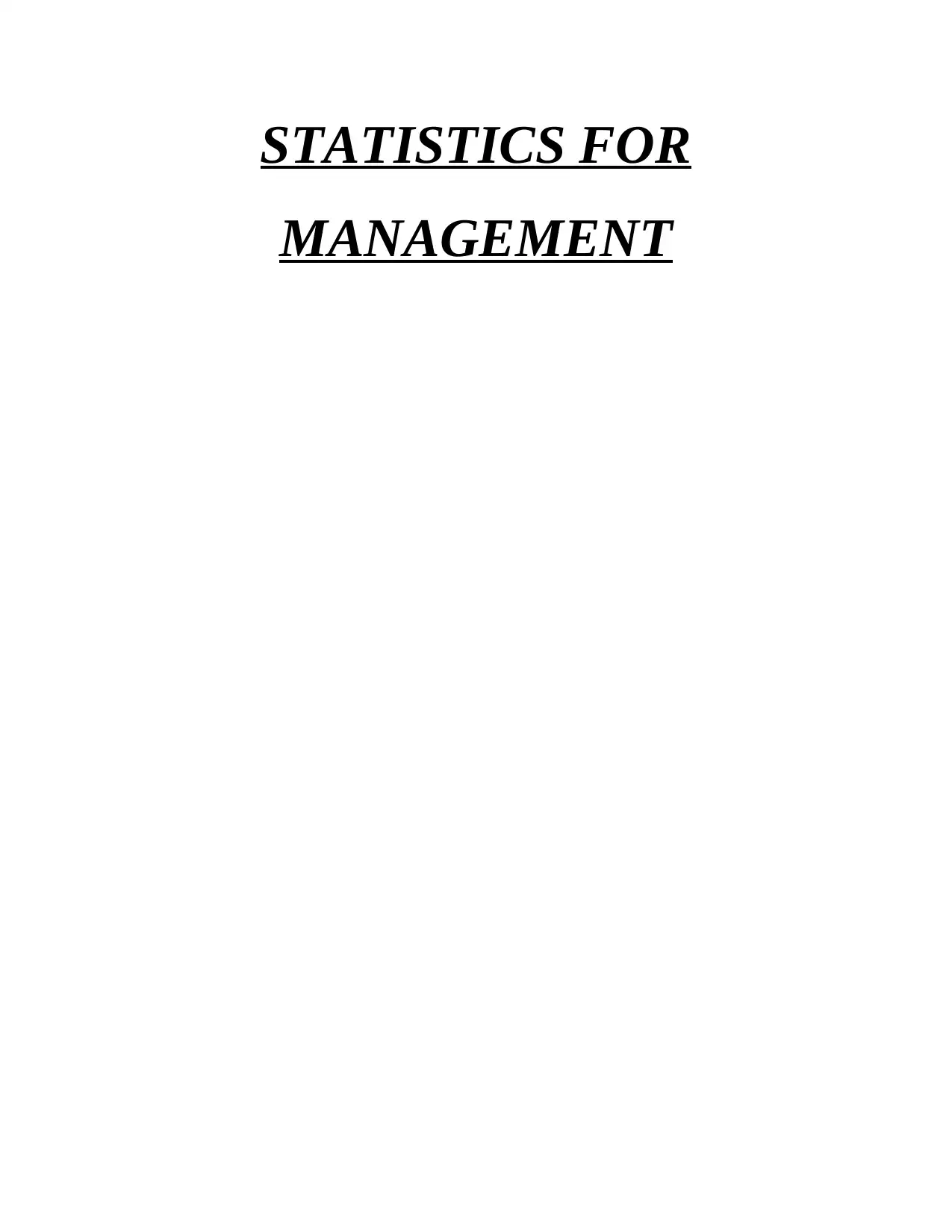
STATISTICS FOR
MANAGEMENT
MANAGEMENT
Paraphrase This Document
Need a fresh take? Get an instant paraphrase of this document with our AI Paraphraser
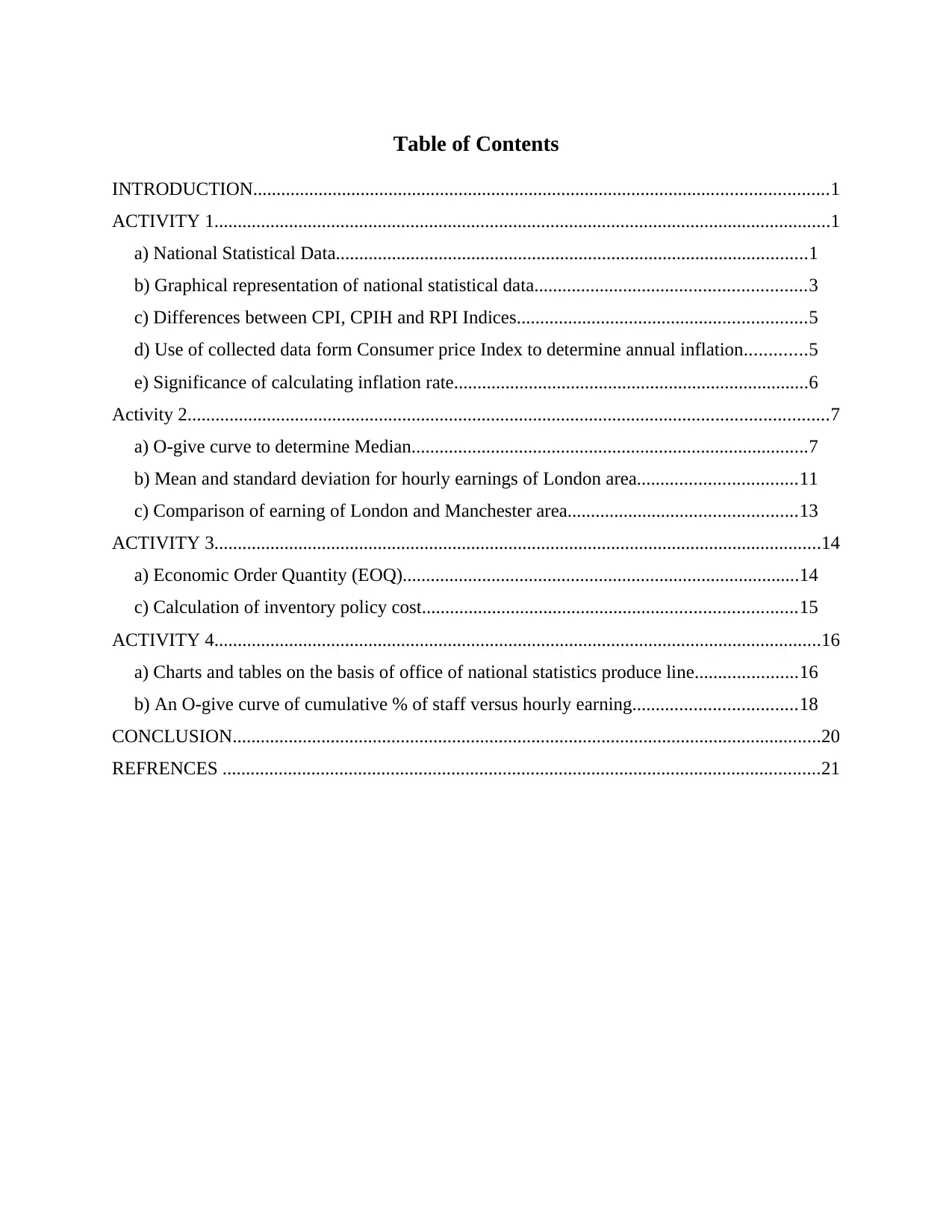
Table of Contents
INTRODUCTION...........................................................................................................................1
ACTIVITY 1....................................................................................................................................1
a) National Statistical Data.....................................................................................................1
b) Graphical representation of national statistical data..........................................................3
c) Differences between CPI, CPIH and RPI Indices..............................................................5
d) Use of collected data form Consumer price Index to determine annual inflation.............5
e) Significance of calculating inflation rate............................................................................6
Activity 2.........................................................................................................................................7
a) O-give curve to determine Median.....................................................................................7
b) Mean and standard deviation for hourly earnings of London area..................................11
c) Comparison of earning of London and Manchester area.................................................13
ACTIVITY 3..................................................................................................................................14
a) Economic Order Quantity (EOQ).....................................................................................14
c) Calculation of inventory policy cost................................................................................15
ACTIVITY 4..................................................................................................................................16
a) Charts and tables on the basis of office of national statistics produce line......................16
b) An O-give curve of cumulative % of staff versus hourly earning...................................18
CONCLUSION..............................................................................................................................20
REFRENCES ................................................................................................................................21
INTRODUCTION...........................................................................................................................1
ACTIVITY 1....................................................................................................................................1
a) National Statistical Data.....................................................................................................1
b) Graphical representation of national statistical data..........................................................3
c) Differences between CPI, CPIH and RPI Indices..............................................................5
d) Use of collected data form Consumer price Index to determine annual inflation.............5
e) Significance of calculating inflation rate............................................................................6
Activity 2.........................................................................................................................................7
a) O-give curve to determine Median.....................................................................................7
b) Mean and standard deviation for hourly earnings of London area..................................11
c) Comparison of earning of London and Manchester area.................................................13
ACTIVITY 3..................................................................................................................................14
a) Economic Order Quantity (EOQ).....................................................................................14
c) Calculation of inventory policy cost................................................................................15
ACTIVITY 4..................................................................................................................................16
a) Charts and tables on the basis of office of national statistics produce line......................16
b) An O-give curve of cumulative % of staff versus hourly earning...................................18
CONCLUSION..............................................................................................................................20
REFRENCES ................................................................................................................................21

⊘ This is a preview!⊘
Do you want full access?
Subscribe today to unlock all pages.

Trusted by 1+ million students worldwide
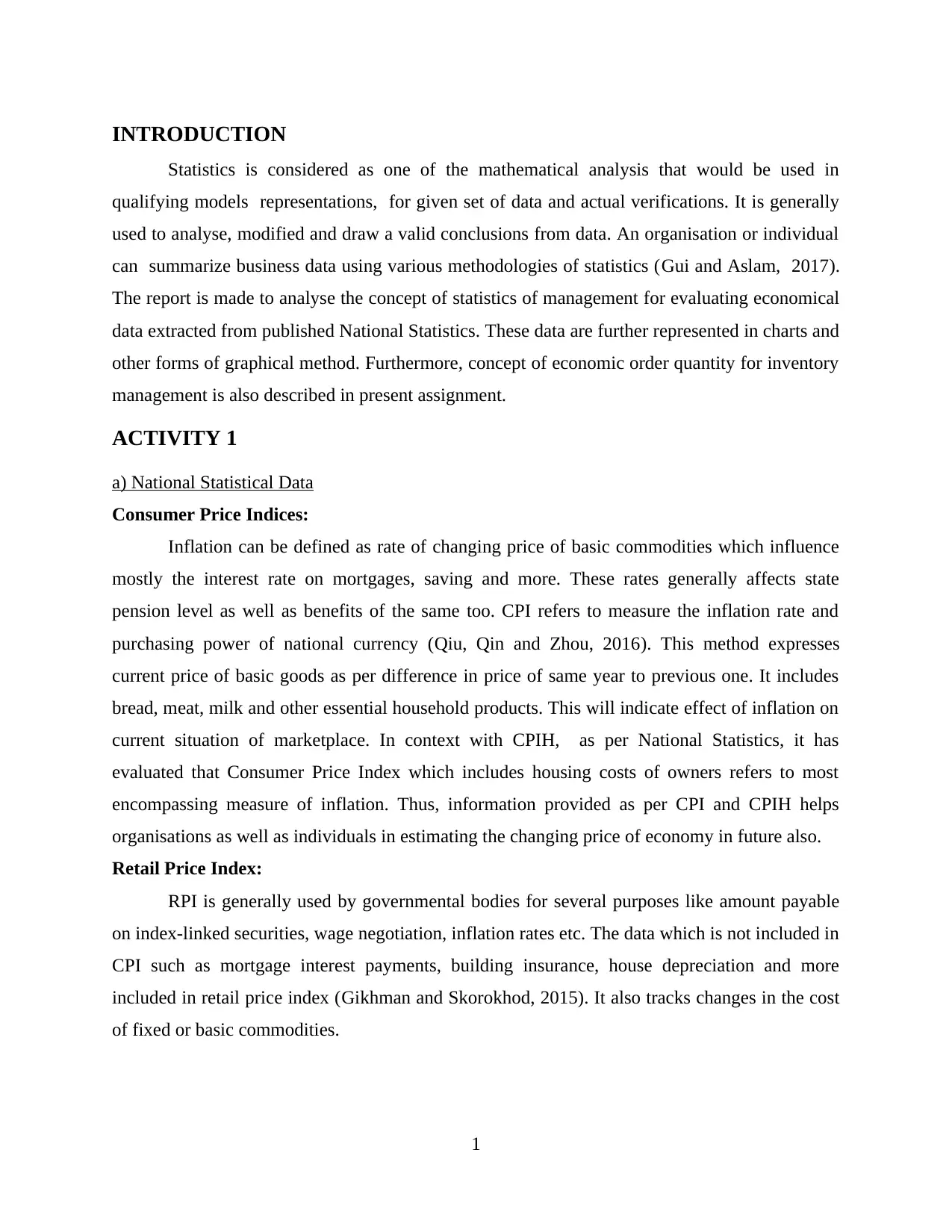
INTRODUCTION
Statistics is considered as one of the mathematical analysis that would be used in
qualifying models representations, for given set of data and actual verifications. It is generally
used to analyse, modified and draw a valid conclusions from data. An organisation or individual
can summarize business data using various methodologies of statistics (Gui and Aslam, 2017).
The report is made to analyse the concept of statistics of management for evaluating economical
data extracted from published National Statistics. These data are further represented in charts and
other forms of graphical method. Furthermore, concept of economic order quantity for inventory
management is also described in present assignment.
ACTIVITY 1
a) National Statistical Data
Consumer Price Indices:
Inflation can be defined as rate of changing price of basic commodities which influence
mostly the interest rate on mortgages, saving and more. These rates generally affects state
pension level as well as benefits of the same too. CPI refers to measure the inflation rate and
purchasing power of national currency (Qiu, Qin and Zhou, 2016). This method expresses
current price of basic goods as per difference in price of same year to previous one. It includes
bread, meat, milk and other essential household products. This will indicate effect of inflation on
current situation of marketplace. In context with CPIH, as per National Statistics, it has
evaluated that Consumer Price Index which includes housing costs of owners refers to most
encompassing measure of inflation. Thus, information provided as per CPI and CPIH helps
organisations as well as individuals in estimating the changing price of economy in future also.
Retail Price Index:
RPI is generally used by governmental bodies for several purposes like amount payable
on index-linked securities, wage negotiation, inflation rates etc. The data which is not included in
CPI such as mortgage interest payments, building insurance, house depreciation and more
included in retail price index (Gikhman and Skorokhod, 2015). It also tracks changes in the cost
of fixed or basic commodities.
1
Statistics is considered as one of the mathematical analysis that would be used in
qualifying models representations, for given set of data and actual verifications. It is generally
used to analyse, modified and draw a valid conclusions from data. An organisation or individual
can summarize business data using various methodologies of statistics (Gui and Aslam, 2017).
The report is made to analyse the concept of statistics of management for evaluating economical
data extracted from published National Statistics. These data are further represented in charts and
other forms of graphical method. Furthermore, concept of economic order quantity for inventory
management is also described in present assignment.
ACTIVITY 1
a) National Statistical Data
Consumer Price Indices:
Inflation can be defined as rate of changing price of basic commodities which influence
mostly the interest rate on mortgages, saving and more. These rates generally affects state
pension level as well as benefits of the same too. CPI refers to measure the inflation rate and
purchasing power of national currency (Qiu, Qin and Zhou, 2016). This method expresses
current price of basic goods as per difference in price of same year to previous one. It includes
bread, meat, milk and other essential household products. This will indicate effect of inflation on
current situation of marketplace. In context with CPIH, as per National Statistics, it has
evaluated that Consumer Price Index which includes housing costs of owners refers to most
encompassing measure of inflation. Thus, information provided as per CPI and CPIH helps
organisations as well as individuals in estimating the changing price of economy in future also.
Retail Price Index:
RPI is generally used by governmental bodies for several purposes like amount payable
on index-linked securities, wage negotiation, inflation rates etc. The data which is not included in
CPI such as mortgage interest payments, building insurance, house depreciation and more
included in retail price index (Gikhman and Skorokhod, 2015). It also tracks changes in the cost
of fixed or basic commodities.
1
Paraphrase This Document
Need a fresh take? Get an instant paraphrase of this document with our AI Paraphraser
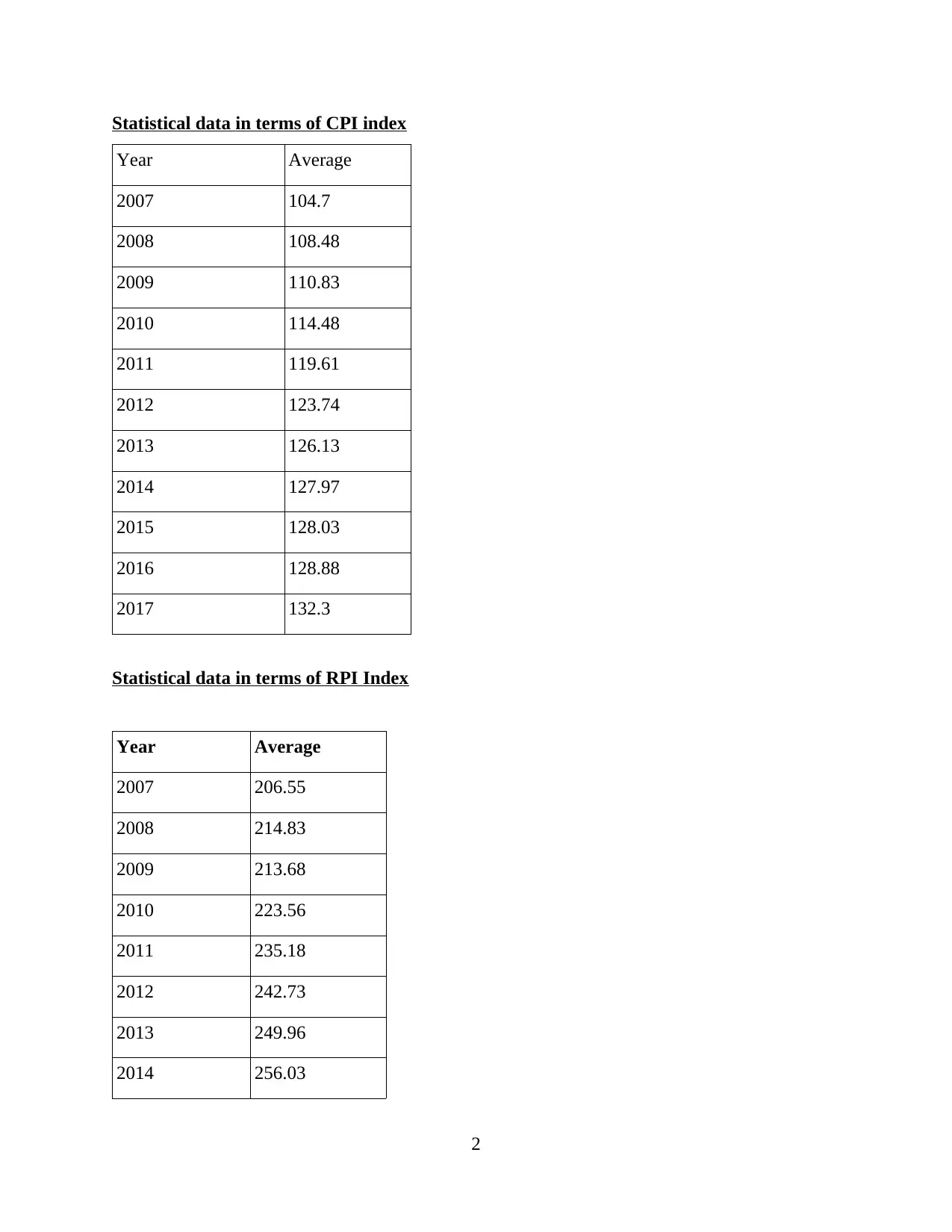
Statistical data in terms of CPI index
Year Average
2007 104.7
2008 108.48
2009 110.83
2010 114.48
2011 119.61
2012 123.74
2013 126.13
2014 127.97
2015 128.03
2016 128.88
2017 132.3
Statistical data in terms of RPI Index
Year Average
2007 206.55
2008 214.83
2009 213.68
2010 223.56
2011 235.18
2012 242.73
2013 249.96
2014 256.03
2
Year Average
2007 104.7
2008 108.48
2009 110.83
2010 114.48
2011 119.61
2012 123.74
2013 126.13
2014 127.97
2015 128.03
2016 128.88
2017 132.3
Statistical data in terms of RPI Index
Year Average
2007 206.55
2008 214.83
2009 213.68
2010 223.56
2011 235.18
2012 242.73
2013 249.96
2014 256.03
2
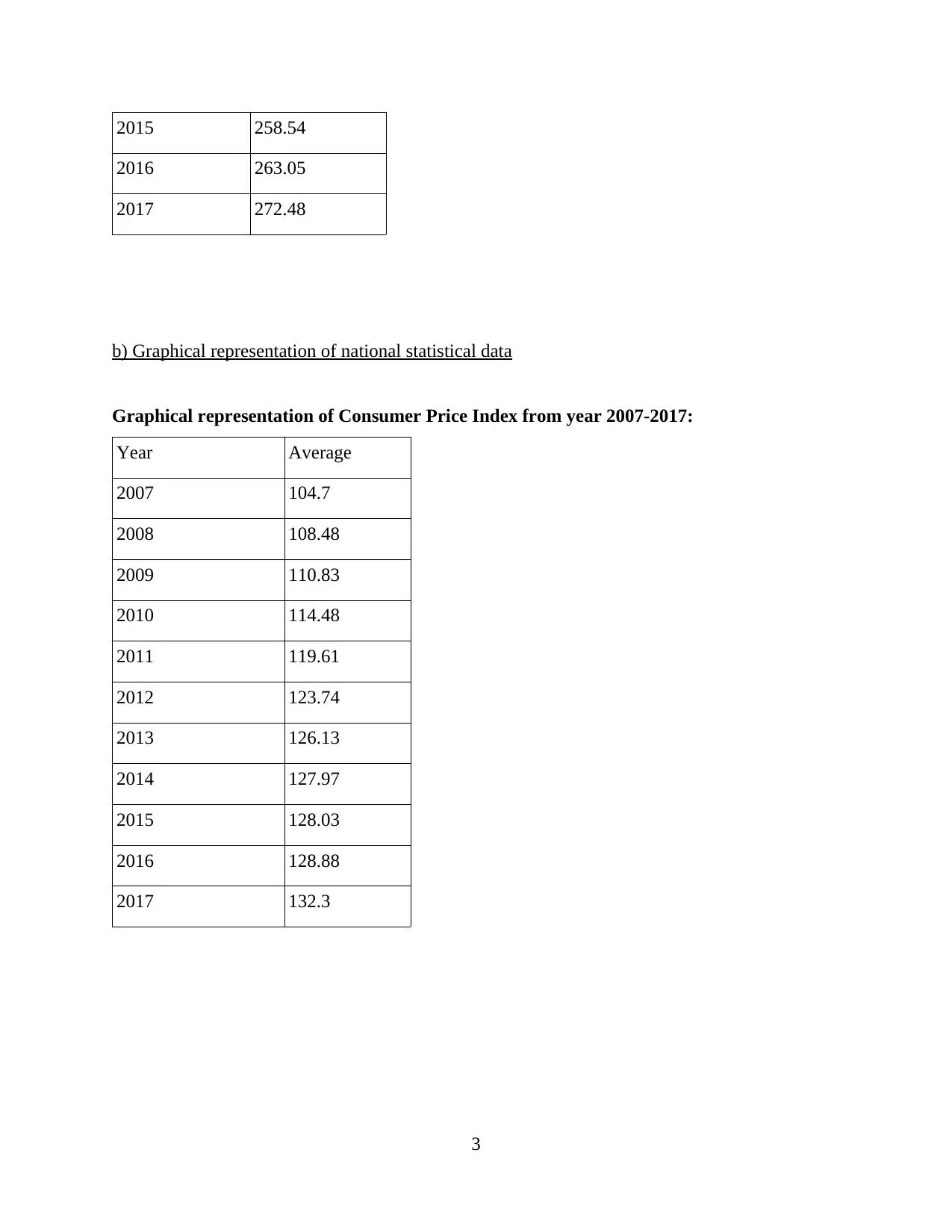
2015 258.54
2016 263.05
2017 272.48
b) Graphical representation of national statistical data
Graphical representation of Consumer Price Index from year 2007-2017:
Year Average
2007 104.7
2008 108.48
2009 110.83
2010 114.48
2011 119.61
2012 123.74
2013 126.13
2014 127.97
2015 128.03
2016 128.88
2017 132.3
3
2016 263.05
2017 272.48
b) Graphical representation of national statistical data
Graphical representation of Consumer Price Index from year 2007-2017:
Year Average
2007 104.7
2008 108.48
2009 110.83
2010 114.48
2011 119.61
2012 123.74
2013 126.13
2014 127.97
2015 128.03
2016 128.88
2017 132.3
3
⊘ This is a preview!⊘
Do you want full access?
Subscribe today to unlock all pages.

Trusted by 1+ million students worldwide
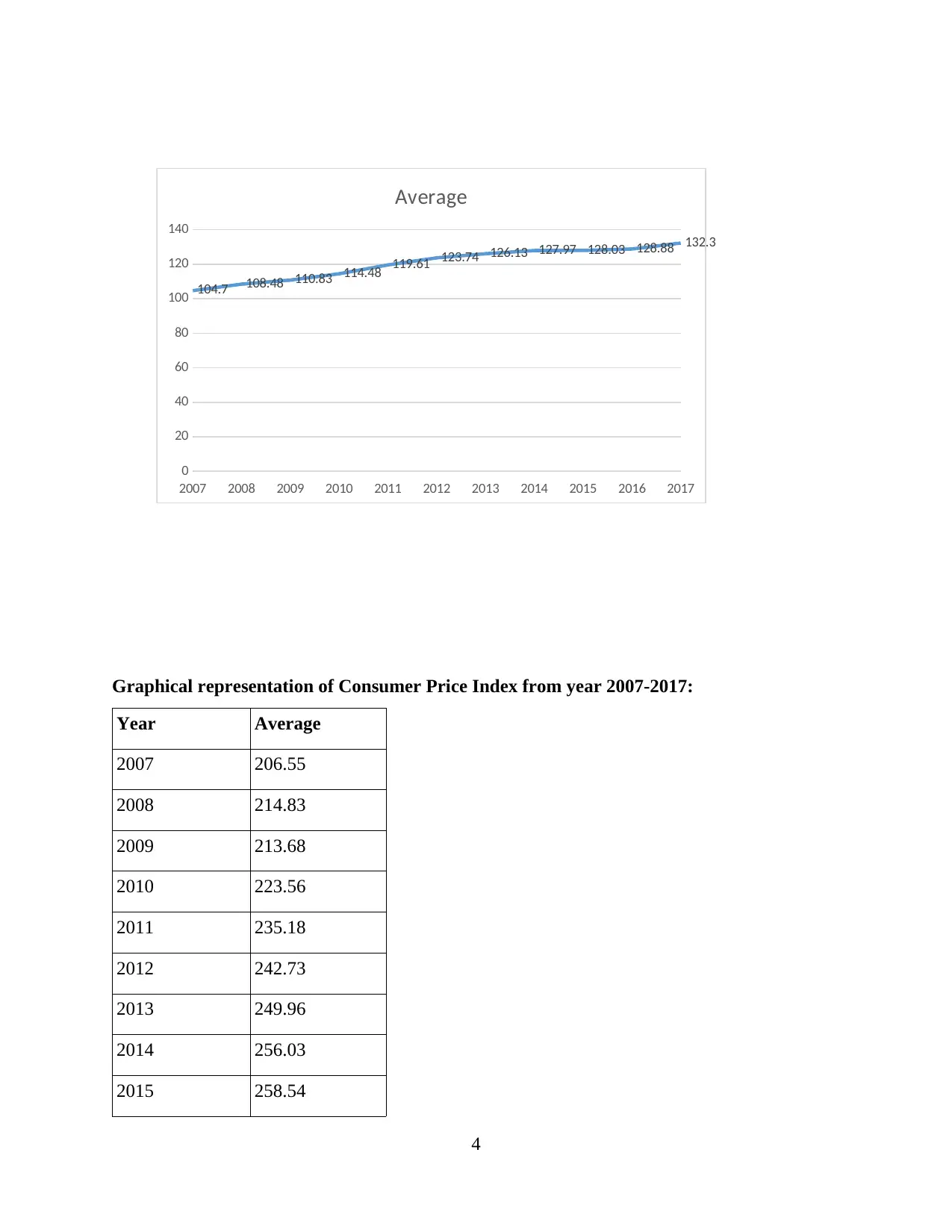
Graphical representation of Consumer Price Index from year 2007-2017:
Year Average
2007 206.55
2008 214.83
2009 213.68
2010 223.56
2011 235.18
2012 242.73
2013 249.96
2014 256.03
2015 258.54
4
2007 2008 2009 2010 2011 2012 2013 2014 2015 2016 2017
0
20
40
60
80
100
120
140
104.7 108.48 110.83 114.48 119.61 123.74 126.13 127.97 128.03 128.88 132.3
Average
Year Average
2007 206.55
2008 214.83
2009 213.68
2010 223.56
2011 235.18
2012 242.73
2013 249.96
2014 256.03
2015 258.54
4
2007 2008 2009 2010 2011 2012 2013 2014 2015 2016 2017
0
20
40
60
80
100
120
140
104.7 108.48 110.83 114.48 119.61 123.74 126.13 127.97 128.03 128.88 132.3
Average
Paraphrase This Document
Need a fresh take? Get an instant paraphrase of this document with our AI Paraphraser
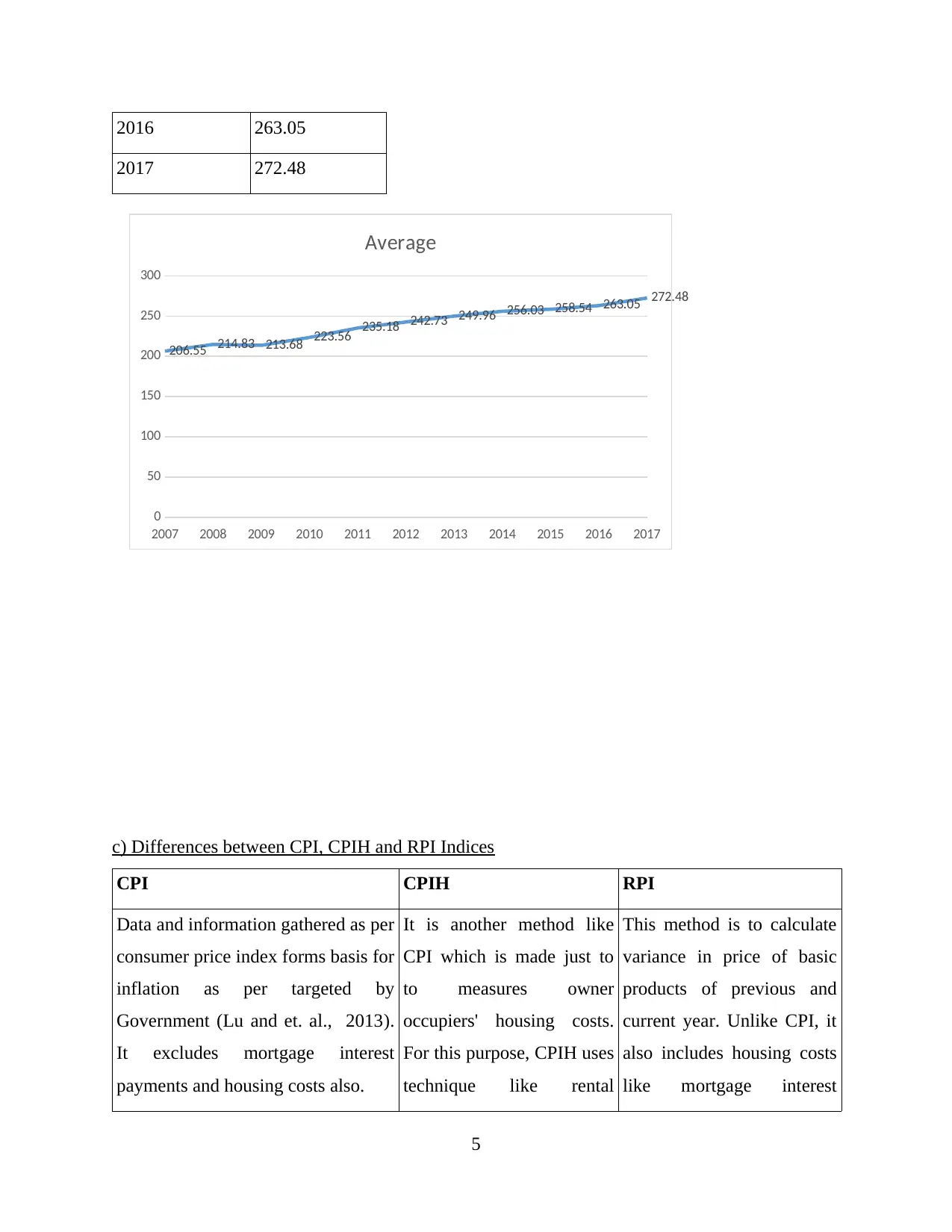
2016 263.05
2017 272.48
c) Differences between CPI, CPIH and RPI Indices
CPI CPIH RPI
Data and information gathered as per
consumer price index forms basis for
inflation as per targeted by
Government (Lu and et. al., 2013).
It excludes mortgage interest
payments and housing costs also.
It is another method like
CPI which is made just to
to measures owner
occupiers' housing costs.
For this purpose, CPIH uses
technique like rental
This method is to calculate
variance in price of basic
products of previous and
current year. Unlike CPI, it
also includes housing costs
like mortgage interest
5
2007 2008 2009 2010 2011 2012 2013 2014 2015 2016 2017
0
50
100
150
200
250
300
206.55 214.83 213.68 223.56 235.18 242.73 249.96 256.03 258.54 263.05 272.48
Average
2017 272.48
c) Differences between CPI, CPIH and RPI Indices
CPI CPIH RPI
Data and information gathered as per
consumer price index forms basis for
inflation as per targeted by
Government (Lu and et. al., 2013).
It excludes mortgage interest
payments and housing costs also.
It is another method like
CPI which is made just to
to measures owner
occupiers' housing costs.
For this purpose, CPIH uses
technique like rental
This method is to calculate
variance in price of basic
products of previous and
current year. Unlike CPI, it
also includes housing costs
like mortgage interest
5
2007 2008 2009 2010 2011 2012 2013 2014 2015 2016 2017
0
50
100
150
200
250
300
206.55 214.83 213.68 223.56 235.18 242.73 249.96 256.03 258.54 263.05 272.48
Average
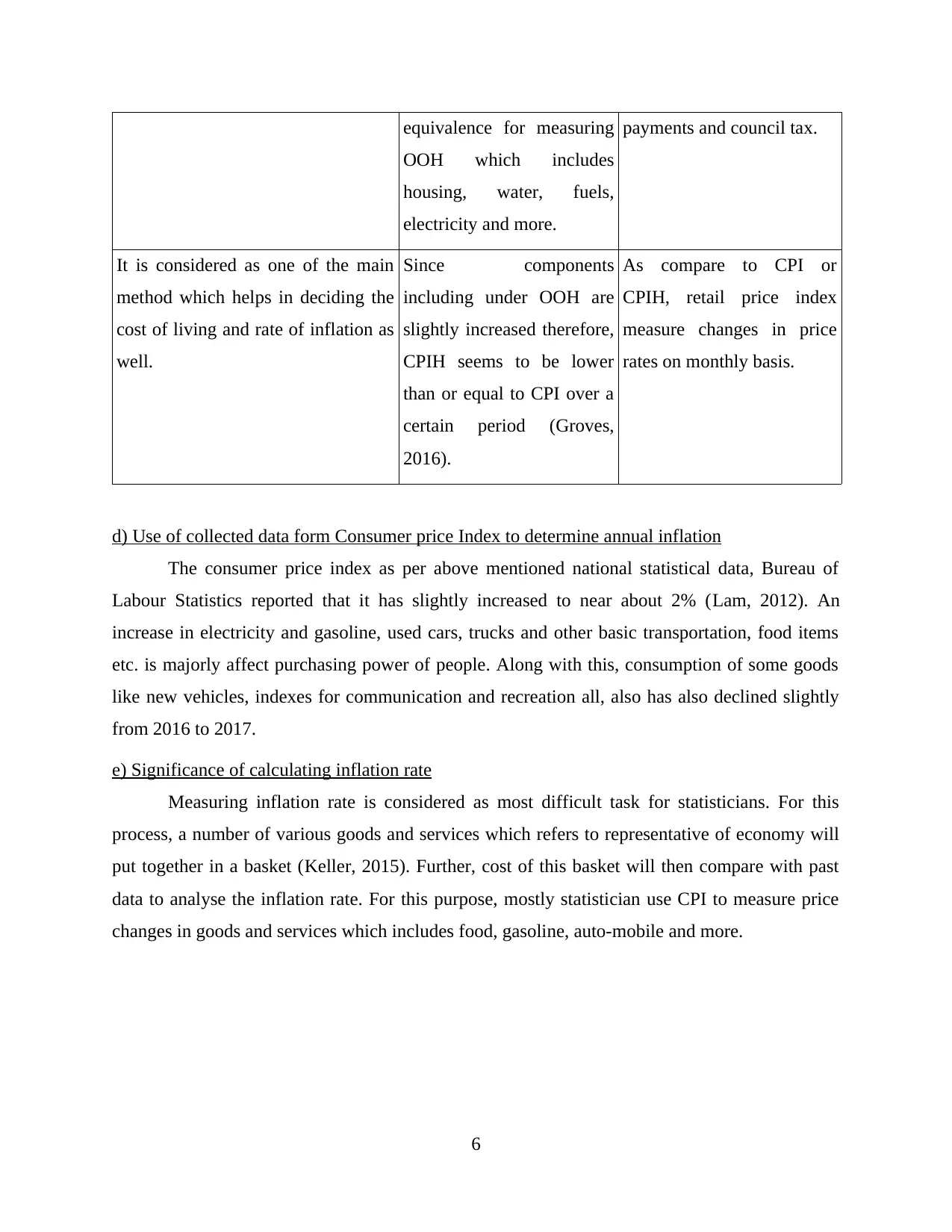
equivalence for measuring
OOH which includes
housing, water, fuels,
electricity and more.
payments and council tax.
It is considered as one of the main
method which helps in deciding the
cost of living and rate of inflation as
well.
Since components
including under OOH are
slightly increased therefore,
CPIH seems to be lower
than or equal to CPI over a
certain period (Groves,
2016).
As compare to CPI or
CPIH, retail price index
measure changes in price
rates on monthly basis.
d) Use of collected data form Consumer price Index to determine annual inflation
The consumer price index as per above mentioned national statistical data, Bureau of
Labour Statistics reported that it has slightly increased to near about 2% (Lam, 2012). An
increase in electricity and gasoline, used cars, trucks and other basic transportation, food items
etc. is majorly affect purchasing power of people. Along with this, consumption of some goods
like new vehicles, indexes for communication and recreation all, also has also declined slightly
from 2016 to 2017.
e) Significance of calculating inflation rate
Measuring inflation rate is considered as most difficult task for statisticians. For this
process, a number of various goods and services which refers to representative of economy will
put together in a basket (Keller, 2015). Further, cost of this basket will then compare with past
data to analyse the inflation rate. For this purpose, mostly statistician use CPI to measure price
changes in goods and services which includes food, gasoline, auto-mobile and more.
6
OOH which includes
housing, water, fuels,
electricity and more.
payments and council tax.
It is considered as one of the main
method which helps in deciding the
cost of living and rate of inflation as
well.
Since components
including under OOH are
slightly increased therefore,
CPIH seems to be lower
than or equal to CPI over a
certain period (Groves,
2016).
As compare to CPI or
CPIH, retail price index
measure changes in price
rates on monthly basis.
d) Use of collected data form Consumer price Index to determine annual inflation
The consumer price index as per above mentioned national statistical data, Bureau of
Labour Statistics reported that it has slightly increased to near about 2% (Lam, 2012). An
increase in electricity and gasoline, used cars, trucks and other basic transportation, food items
etc. is majorly affect purchasing power of people. Along with this, consumption of some goods
like new vehicles, indexes for communication and recreation all, also has also declined slightly
from 2016 to 2017.
e) Significance of calculating inflation rate
Measuring inflation rate is considered as most difficult task for statisticians. For this
process, a number of various goods and services which refers to representative of economy will
put together in a basket (Keller, 2015). Further, cost of this basket will then compare with past
data to analyse the inflation rate. For this purpose, mostly statistician use CPI to measure price
changes in goods and services which includes food, gasoline, auto-mobile and more.
6
⊘ This is a preview!⊘
Do you want full access?
Subscribe today to unlock all pages.

Trusted by 1+ million students worldwide
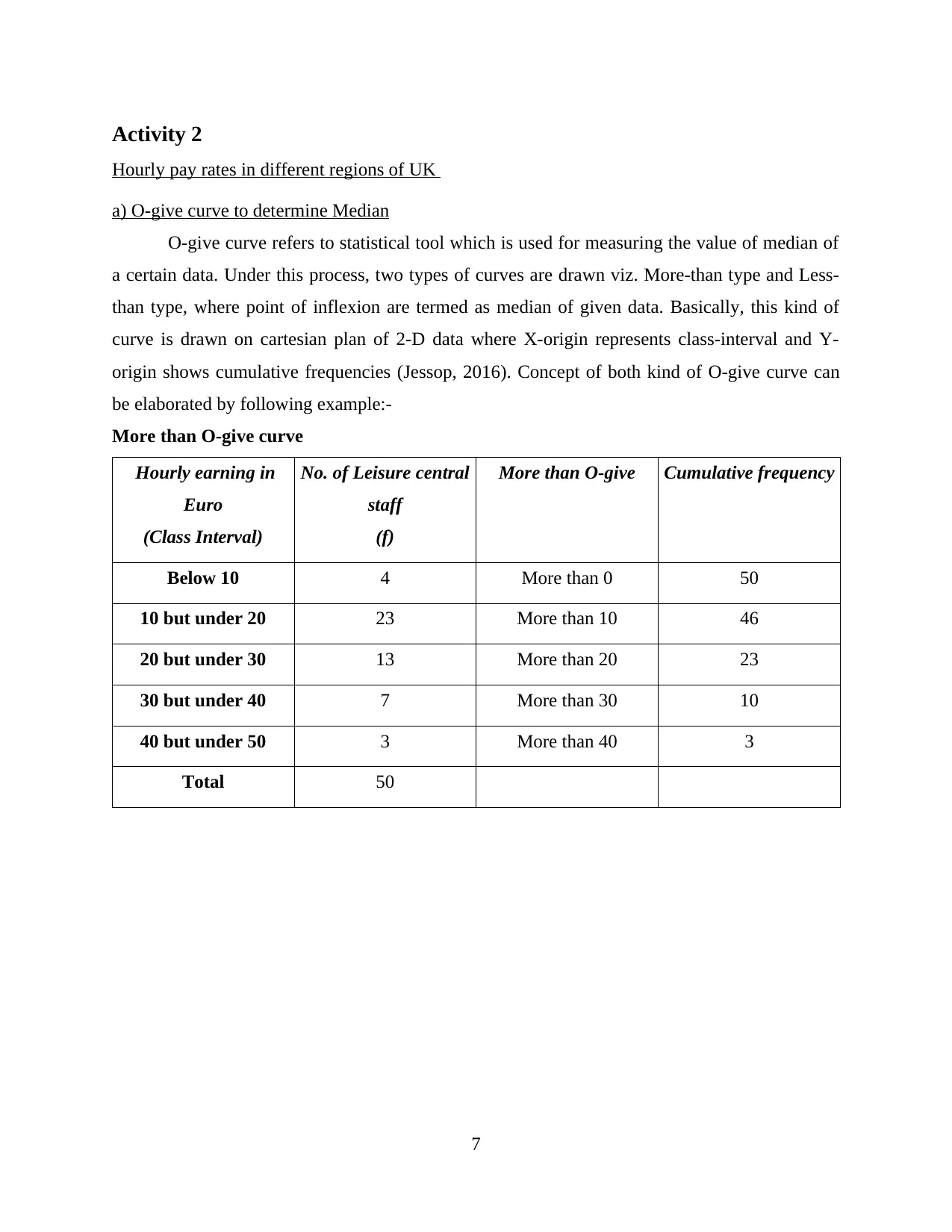
Activity 2
Hourly pay rates in different regions of UK
a) O-give curve to determine Median
O-give curve refers to statistical tool which is used for measuring the value of median of
a certain data. Under this process, two types of curves are drawn viz. More-than type and Less-
than type, where point of inflexion are termed as median of given data. Basically, this kind of
curve is drawn on cartesian plan of 2-D data where X-origin represents class-interval and Y-
origin shows cumulative frequencies (Jessop, 2016). Concept of both kind of O-give curve can
be elaborated by following example:-
More than O-give curve
Hourly earning in
Euro
(Class Interval)
No. of Leisure central
staff
(f)
More than O-give Cumulative frequency
Below 10 4 More than 0 50
10 but under 20 23 More than 10 46
20 but under 30 13 More than 20 23
30 but under 40 7 More than 30 10
40 but under 50 3 More than 40 3
Total 50
7
Hourly pay rates in different regions of UK
a) O-give curve to determine Median
O-give curve refers to statistical tool which is used for measuring the value of median of
a certain data. Under this process, two types of curves are drawn viz. More-than type and Less-
than type, where point of inflexion are termed as median of given data. Basically, this kind of
curve is drawn on cartesian plan of 2-D data where X-origin represents class-interval and Y-
origin shows cumulative frequencies (Jessop, 2016). Concept of both kind of O-give curve can
be elaborated by following example:-
More than O-give curve
Hourly earning in
Euro
(Class Interval)
No. of Leisure central
staff
(f)
More than O-give Cumulative frequency
Below 10 4 More than 0 50
10 but under 20 23 More than 10 46
20 but under 30 13 More than 20 23
30 but under 40 7 More than 30 10
40 but under 50 3 More than 40 3
Total 50
7
Paraphrase This Document
Need a fresh take? Get an instant paraphrase of this document with our AI Paraphraser
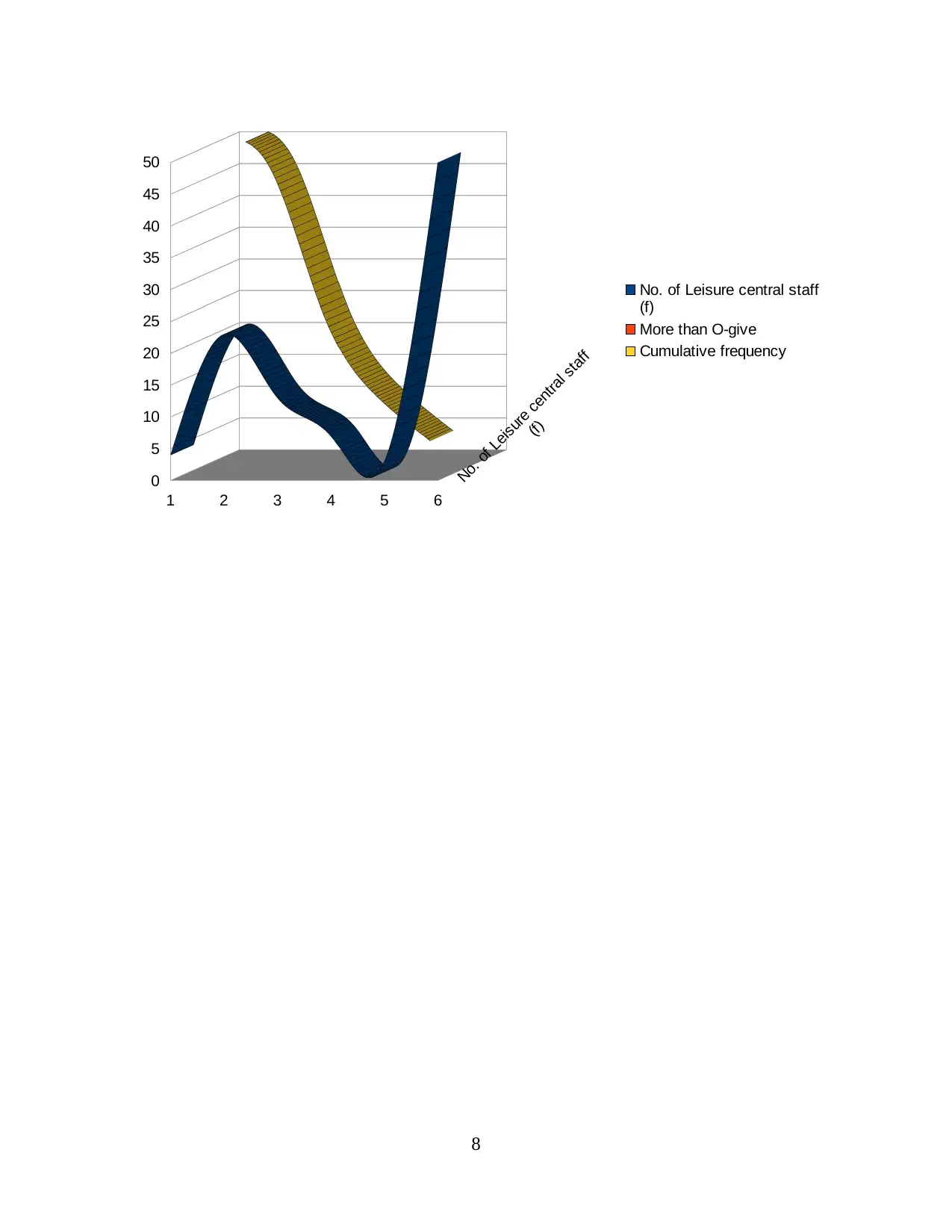
8
1 2 3 4 5 6
0
5
10
15
20
25
30
35
40
45
50
No. of Leisure central staff
(f)
No. of Leisure central staff
(f)
More than O-give
Cumulative frequency
1 2 3 4 5 6
0
5
10
15
20
25
30
35
40
45
50
No. of Leisure central staff
(f)
No. of Leisure central staff
(f)
More than O-give
Cumulative frequency
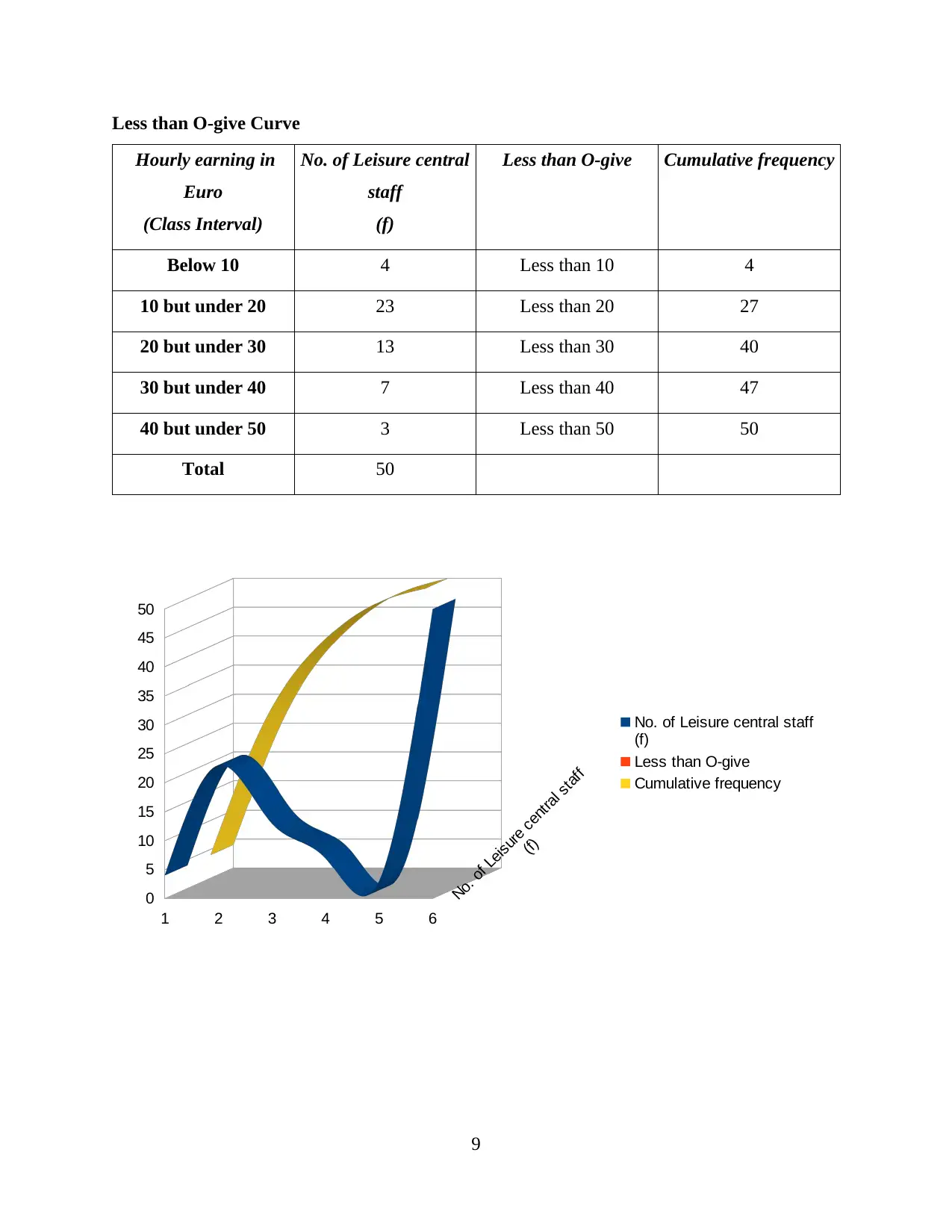
Less than O-give Curve
Hourly earning in
Euro
(Class Interval)
No. of Leisure central
staff
(f)
Less than O-give Cumulative frequency
Below 10 4 Less than 10 4
10 but under 20 23 Less than 20 27
20 but under 30 13 Less than 30 40
30 but under 40 7 Less than 40 47
40 but under 50 3 Less than 50 50
Total 50
9
1 2 3 4 5 6
0
5
10
15
20
25
30
35
40
45
50
No. of Leisure central staff
(f)
No. of Leisure central staff
(f)
Less than O-give
Cumulative frequency
Hourly earning in
Euro
(Class Interval)
No. of Leisure central
staff
(f)
Less than O-give Cumulative frequency
Below 10 4 Less than 10 4
10 but under 20 23 Less than 20 27
20 but under 30 13 Less than 30 40
30 but under 40 7 Less than 40 47
40 but under 50 3 Less than 50 50
Total 50
9
1 2 3 4 5 6
0
5
10
15
20
25
30
35
40
45
50
No. of Leisure central staff
(f)
No. of Leisure central staff
(f)
Less than O-give
Cumulative frequency
⊘ This is a preview!⊘
Do you want full access?
Subscribe today to unlock all pages.

Trusted by 1+ million students worldwide
1 out of 24
Related Documents
Your All-in-One AI-Powered Toolkit for Academic Success.
+13062052269
info@desklib.com
Available 24*7 on WhatsApp / Email
![[object Object]](/_next/static/media/star-bottom.7253800d.svg)
Unlock your academic potential
Copyright © 2020–2025 A2Z Services. All Rights Reserved. Developed and managed by ZUCOL.





